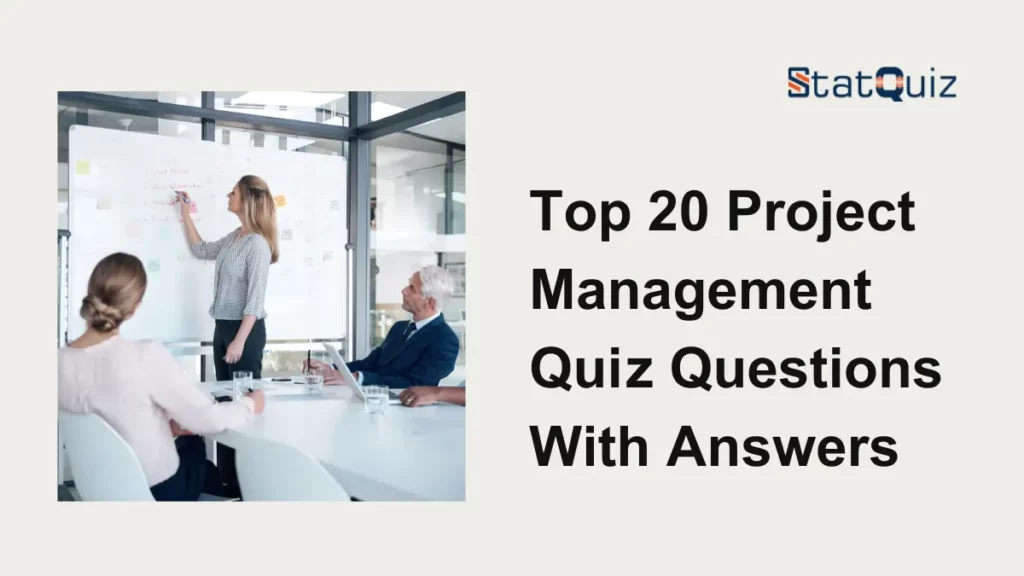Testing your project management knowledge can be a fun and effective way to identify strengths and areas for improvement. A good project manager needs expertise across a wide range of topics like scope, scheduling, budgeting, quality, human resources, communications, risk, and procurement. Preparing for a project management quiz or test helps reinforce key concepts and best practices.
In this post, we’ve compiled 20 quiz questions frequently asked about core project management themes. The questions get progressively more difficult and cover beginner, intermediate, and advanced PM topics. An explanation of the correct answer follows each question. Use these project management quiz questions and answers to assess your current knowledge and learn something new about successfully managing projects from start to finish.
So, let’s move on to the Quiz Questions With Answers.
Q1. Which of the following executive roles is responsible for overall priority setting, project selection, and prioritization, general guidance, and encouragement?
Select one:
a. Sponsor
b. Chief Projects Officer
c. Project Management Office
d. Steering TeamQ2. All of the following are advantages associated with managing projects in a projectized organization EXCEPT:
Select one:
a. Departmental barriers are reduced.
b. One boss – the project manager
c. Workers know they will still have a job when they finish work on a project.
d. Response times and decision-making are swift.Q3. The Chief Projects Officer's responsibilities include ensuring that the steering team does all of the following EXCEPT:
Select one:
a. captures lessons learned from completed projects
b. monitors and controls the implementation of projects
c. ensures enough resources (people, money, and other resources) are available to perform the projects
d. selects appropriate project sponsors and teamsQ4. When trying to understand a corporate culture, it is helpful to understand the types of power that are used. In “power cultures”:
Select one:
a. supervisors exert a great deal of economic and political power.
b. workers closely follow their appointed roles.
c. display an attitude that collaboration is satisfying and stimulating.
d. more deference is paid to knowledge than to formal authority.Q5. Which of the following are among the challenges faced by project managers?
Select one:
a. They frequently have more authority than responsibility.
b. They are not allowed to be flexible about how the project should be accomplished.
c. They must learn how to accomplish project work unilaterally – on their own.
d. They must effectively deal with networks of people both within and outside the parent company.Q6. In agile projects, overall planning is at a high level, and only the near-term work is planned in detail. The project work is conducted in iterations (sprints) that are normally:
Select one:
a. assigned to one person on the team
b. a variable length depending on project scope
c. a fixed length of two or four weeks
d. no more than one calendar yearQ7. During project execution, the project sponsor's responsibilities include all of these EXCEPT:
Select one:
a. charter the project
b. ensure quality
c. nurture key stakeholders
d. ensure communicationsQ8. Which of the following is an advantage associated with the matrix organization?
Select one:
a. Unity of command – one “boss” for each employee.
b. Hard to monitor and control.
c. Shorter response times and quicker decisions.
d. Increased knowledge transfer between projects.Q9. The project life cycle where project teams plan in short bursts (generally of one to four weeks), often called sprints or iterations, is referred to as _:
Select one:
a. Predictive, plan-driven project life cycle
b. Adaptive, change-driven project life cycle
c. Construction project life cycle
d. Process improvement life cycleQ10. Which of the following organizational structures is designed to achieve a balance of task focus and technical capability?
Select one:
a. siloed organization
b. projectized organization
c. functional organization
d. matrix organizationQ11. A scrum master is a project manager who serves and leads in a collaborative, facilitating manner.
Select one:
a. True
b. FalseQ12. In a projected organization, most people are assigned to a project and report upward through the project manager.
Select one:
a. True
b. FalseQ13. Hallmarks of “personal cultures” are skill-based assignments, self-motivated workers, and more deference paid to knowledge than to formal authority.
Select one:
a. True
b. FalseQ14. A matrix organization is any organization in which the project manager or project team leader actually shares responsibility for the project with a number of individual functional managers.
Select one:
a. True
b. FalseQ15. When the project sponsor and manager are determining how to create the project culture, ethics should be an important consideration.
Select one:
a. True
b. FalseQ16. If the project scope is hard to define early in the project and/or much change is expected, an Agile project management approach often works better.
Select one:
a. True
b. FalseQ17. The decision to kill a project if needed is typically reached jointly through agreement between the project customer and the project contractor.
Select one:
a. True
b. FalseQ18. Projectized organizations are especially effective at helping team members to maintain their discipline-specific competencies.
Select one:
a. True
b. FalseQ19. Organizational culture consists of values, social rituals, symbols, work ethics, organizational behavior, beliefs, and practices that are shared among members of the organization and are taught to new members.
Select one:
a. True
b. FalseQ20. In a functional organization, workers can learn readily from others in their discipline and keep their skills sharp.
Select one:
a. True
b. False
Answers (Project Management Quiz Questions)
- d
- c
- a
- a
- d
- c
- a
- d
- b
- d
- a
- a
- b
- a
- a
- a
- b
- b
- a
- a

